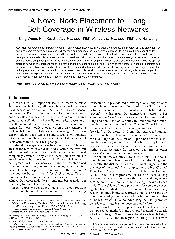摘要
Coverage is an important issue in many wireless networks. In this paper, we address the problem of node placement for ensuring complete coverage in a long belt scenario and propose a novel placement approach to minimize the number of nodes needed. In our work, each node is assumed to be able to cover a disk area centered at itself with a fixed radius, then a divide-and-cover node placement method is proposed. In the proposed method, a long belt is divided into some sub-belts (if necessary), and then a string of nodes are placed parallel to the long side of each sub-belt to completely cover the sub-belt. We then determine the optimal distance between two adjacent nodes in a string and the number of such strings to minimize the number of nodes for complete belt coverage. Theoretical proofs and analysis show that compared with other node placement including the well-known regular triangular-lattice placement, the proposed method can achieve lower node density in some cases when the belt height is not very large. A combination of the proposed method and the triangular-lattice placement is then proposed, and the optimal ranges of the belt height for their respective applications to achieve the lowest node density are computed.
- 出版日期2013-12
- 单位华中科技大学
